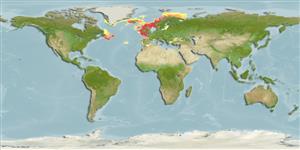Classification / Names
Common names from other countries
Main reference
Size / Weight / Age
Max length : 200 cm TL male/unsexed; (Ref. 1371); common length : 106 cm TL male/unsexed; (Ref. 1371); max. published weight: 45.0 kg (Ref. 35388); max. reported age: 25 years (Ref. 35388)
Length at first maturity
Lm 90.0, range 90 - 100 cm
Environment
Marine; demersal; oceanodromous (Ref. 51243); depth range 100 - 1000 m (Ref. 35388), usually 100 - 400 m (Ref. 35388)
Climate / Range
Temperate, preferred 14°C (Ref. 107945); 75°N - 35°N, 55°W - 44°E (Ref. 54595)
Distribution
Northwest Atlantic: off southern Greenland and Canada. Northeast Atlantic: Barents Sea and Iceland to Morocco. Mediterranean Sea: northwestern Mediterranean only.
Countries | FAO areas | Ecosystems | Occurrences | Introductions
Short description
Dorsal
spines
(total): 0;
Dorsal
soft rays
(total): 75-83;
Anal
soft rays: 58 - 64;
Vertebrae: 63 - 65. Upper jaw projecting beyond lower one. Color is reddish brown dorsally, grading to white ventrally. The posterior areas of the vertical fins dark with pale margins. The sides distinctly marbled (Ref. 232). Barbel is present in the chin, longer than the diameter of the eye. Black spot in the rear end of the first dorsal fin. Caudal peduncle stout compared to blue ling (Ref. 35388).
IUCN Red List Status (Ref. 115185)
Threat to humans
Harmless
Human uses
Fisheries: highly commercial; gamefish: yes
More information
ReferencesAquacultureAquaculture profileStrainsGeneticsAllele frequenciesHeritabilityDiseasesProcessingMass conversion
Tools
Special reports
Download XML
Internet sources
Estimates of some properties based on models
Phylogenetic diversity index
PD50 = 0.6250 many relatives (e.g. carps) 0.5 - 2.0 few relatives (e.g. lungfishes)
Trophic Level
4.4 ±0.2 se; Based on diet studies.
Resilience
Low, minimum population doubling time 4.5 - 14 years (K=0.12; tm=5-6; tmax=25; Fec=60 million)
Vulnerability
Very high vulnerability (77 of 100)
Price category
